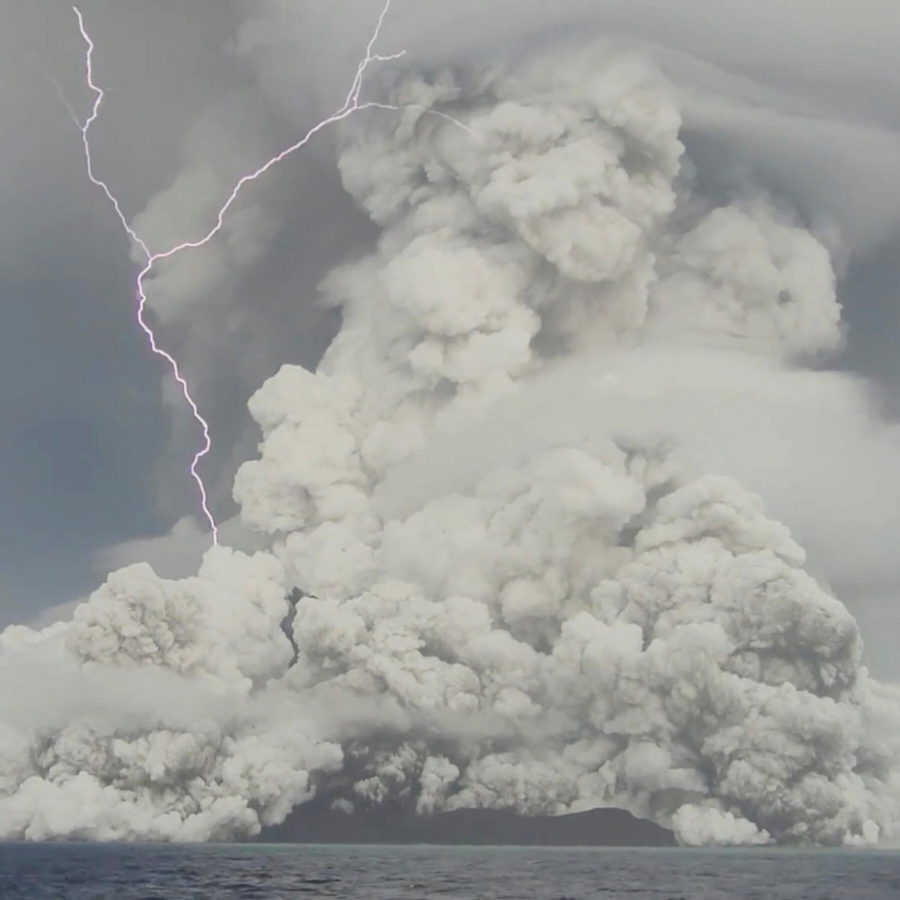Hunga Tongoa-Hunga Ha’apai eruption
March 9, 2022
On January 15th, 2022, the Tonga volcano erupted, sending shock waves across the Pacific Ocean, and making history. That day, residents of Tonga and its surrounding islands saw an immense column of ash rising miles into the air.
The volcano, named Hunga Tonga–Hunga Ha‘apai, is an active volcano lying in the southwestern part of the Pacific Ocean, 1000 miles north off the coast of New Zealand and just 40 miles off the coast of Tonga’s capital of Nuku’alofa. The region is unique for being home to dozens of volcanoes, both active and dormant, and has seen several smaller scale eruptions in the past decade.
This eruption was recorded as one of the largest volcanic eruptions in recent years. According to research by NASA, the Volcano’s eruption was clearly visible in space. The eruption was caused by over 20 years of magma buildup and gas pressure under the surface, as well as the volcano’s contact with seawater turning into steam. This generated an explosion as powerful as 16 megatons of TNT, which is a thousand times more powerful than a nuclear bomb. The eruption itself happened 150 meters under the water. The effects of the volcano, including shock waves, tsunamis, and ash-spread could be felt 5,000 miles away in Hawaii.
The plumes of the eruption were able to rise 36 miles above the earth. This eruption became the first satellite-recorded volcanic eruption in history in which the volcanic plumes were able to reach the mesosphere, which goes beyond the ozone layer and nears outer space.
The Tonga volcanic crater, which once connected two islands, has effectively sunken, leaving behind two smaller islands.
Damage caused by the eruption was drastic. In total, the 36 islands that make up the Tonga Archipelago are inhabited by 105,000 residents. For 3 days after the eruption, all communication to and from Tonga was cut off due to ashes blocking satellites. Because of this, the needs of Tonga could not be met by the outside world, and relief supplies were not able to be delivered for several days. On top of this, Tsunamis caused major damage to Tonga’s coastlines, and has caused 3 deaths. Volcanic ash was spread all over the archipelago, covering the once green landscape in gray matter, and causing major health concerns due to risks of breathing in the volcanic ash.
The eruption has made impacts on the livelihoods of at least 80 percent of the Tonga population, and resulted in an estimated 90 million dollars in damages. Since then, New Zealand and Hawaii’s governments have agreed to help Tonga cover some of these damages and send relief supplies.
“This was an enormous event, because people can hear it from 10,000 miles away.” Kevin Hagan, Environmental Science teacher at LFA, comments. “The large amounts of ash and sulfur and aerosols getting into the atmosphere can actually lower greenhouse gasses by blocking sunlight.” This meant the plume was so large that it covered ultraviolet rays from entering the atmosphere in the southern pacific region for several days.
“It’s a very historic eruption, and something you won’t even see every 100 years.” Hagan says.









